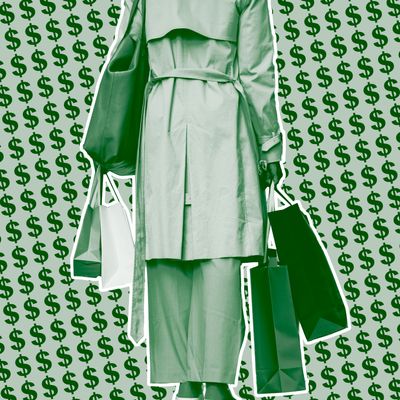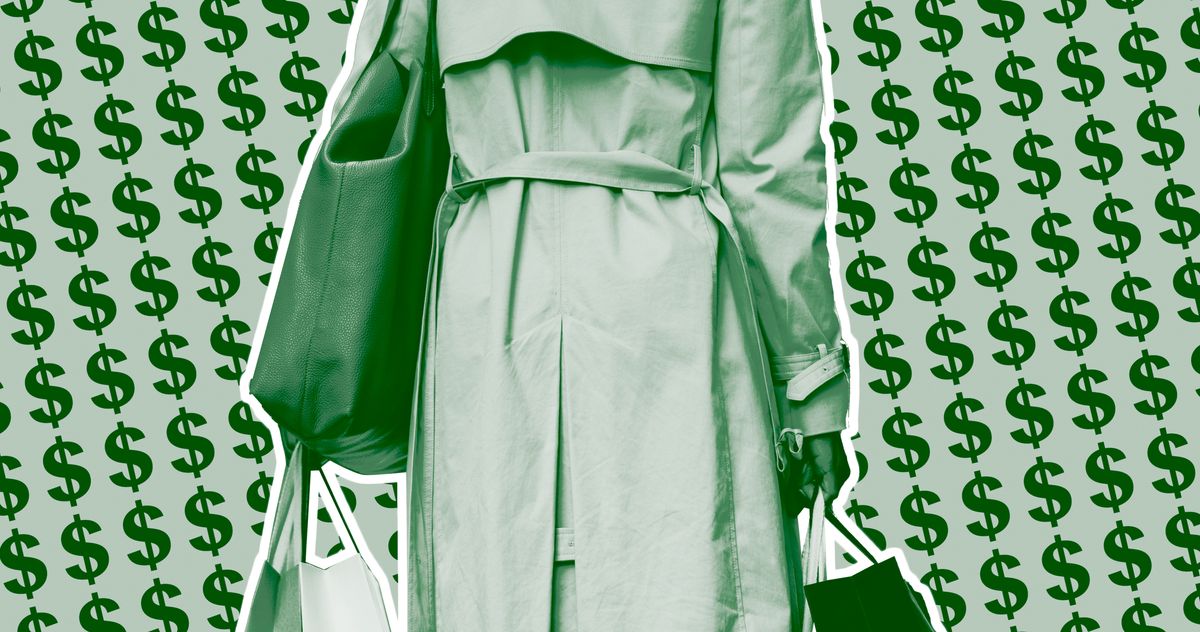
Photo illustration: by The Cut; Photo: Getty Images
Chrissie Milan has always loved fashion, but earlier this year she realized her shopping habits were spiraling out of control. “If I had to go to an event, I would just buy something new a few days before, rather than thinking of an outfit beforehand or looking at what I already had,” she says. As a result, her closet was jam-packed with stuff, and she was spending more money than she was willing to admit (or could count). “It just didn’t feel responsible, financially or otherwise,” she says. “I felt like I had lost control.”
Chrissie researched ways to budget better, but most of the advice she found came from people whose lives looked very different to hers. She couldn’t relate to their strict, home-cooking, capsule wardrobe lifestyle; she’s a 26-year-old video producer in London and spends most evenings with friends or working late. “I love dressing up and being out and about. I love getting my nails done. I love meeting friends and I go to a lot of events,” she says. “I wanted to keep doing those things, but in a way that involved less consumption.”
At first she went through a hard detox, trying a strict shopping ban—no new clothes, period. At first, that was OK—especially because it saved her about $2,000 in four months—but then it started to get depressing. Clothes brought her a lot of joy, and while it was nice to find new ways to wear the things she already owned, she didn’t want to give up shopping entirely just for the sake of restriction. After six months, she ended the ban and bought a few things she’d had her eye on for a long time: a new pair of jeans, shoes, jewelry. She’s happy with her purchases, and they didn’t blow her budget. But she’s still learning to find the middle ground between impulsive shopping and no shopping. “I wish there were more role models for people who plan their finances properly and still live the life I want to live,” she says.
She’s not alone—most Americans wish they had a better relationship with shopping, feeling torn between the allure of something new and the reality of what they already have. For those who love to dress up and browse for clothes almost as a hobby (or their actual job if they work in a fashion-related industry), it’s hard not to overdo it, especially this time of year. The sales are so good! The urge to shop for back-to-school is strong! The targeted ads are relentless! The internet becomes a financial minefield.
Anna Newton, who runs a fashion newsletter called Edit the wardroberecently wrote about the struggle of resisting the shopping spree. She recommends “alternative ways to satisfy the urge”—small, doable tasks that can provide just as much (if not more) a sense of satisfaction as cleaning out your closet (you don’t have to go all Marie Kondo; just take 20 minutes to hang and fold everything neatly), ironing or steaming wrinkled clothes, sorting out out-of-season items and packing them into a storage box, or creating a digital mood board of outfits instead of actually buying them.
Marielle Elizabeth Terhart, a plus-size photographer and fashion consultant, admits she struggles with this too. “Sometimes things I’ve ordered arrive in the mail and I’m not even excited to open them anymore,” she says. “That usually means I have to take a break, take a break from shopping and find other ways to get that dopamine hit.”
It’s tough, though, when her job literally involves looking at clothes and thinking about them all day long. “I’m constantly online, looking at trend cycles and interpreting them from the perspective of my size and that of other plus-size people,” she says. “I spend a lot of time scouring the internet to find things that excite and inspire me, and the first thought that follows is: Do I need this in my life now?”
Of course, the more she looks at it, the more likely the answer is “yes.” So she’s developed a number of ways to check in with herself – she thinks of them as “mental barriers,” or ways to reduce her consumption (and spending). She says they’re not foolproof, but they help.
That’s what group chats are for. “I encourage people to find a few close friends who know what your goals are, know your personal style, and are willing to gently hold you accountable when you really want something,” she says. “I have a friend who is great at that. I send her a link and she’ll say, ‘You already have this,’ or ‘Where in the world are you going to wear that?’ And she’s always right.”
Even if you don’t have anyone who truly understands your style, getting a second opinion can help you think more deeply about why you want something in the first place, or give you pause enough to change your mind.
Terhart also applies the third-party rule in such a way that she considers herself the costume designer of her own life. “I know that sounds cheesy, but it helps me zoom out of the picture,” she says. “I think If I were a costume designer on a film set and I was dressing my own character, would I choose this item of clothing for her wardrobe? Will the actress be comfortable in it? For me, it’s a way to step back and take some of my emotions out of the decision.”
“I’ve learned that there are four types of outfits that I actually wear, and if an item of clothing doesn’t easily fall into one of those categories, I’m just not going to wear it often enough to justify the expense,” says Terhart. Everyone’s outfit categories are different, she adds, and they change throughout different stages of life. But it’s worth putting in some effort to understand your own category.
For reference, Terhart’s outfits are: (1) casual everyday wear for running errands and meeting friends, (2) dressy clothes for attending events or taking photos, (3) comfortable, professional clothes for her work as a photographer where she “needs to be able to lie on the floor but still look put-together,” and (4) loungewear, athleisure, and workout clothes.
“If the item I want doesn’t fall into those categories, in reality I shouldn’t buy it and should admire it instead,” she says. “At this point in my life, I don’t need clothes for a first date. I don’t need clothes for going to the bar. And it’s helpful to remember that.”
There’s often a more straightforward way to try out an outfit or trend you like. “For example, if you really like the red accessories trend, do you have to buy a $500 bag or can you buy a pair of red socks?” asks Terhart.
She also recommends recreating a look with your existing wardrobe before getting something new. “Look at photos or watch fashion shows, then look in your closet to see what goes with it,” she says. Don’t be afraid to dye, tailor or otherwise repurpose things you already have. For example, Terhart recently took an old pair of shorts and dyed them burgundy to wear in the fall. “Since I dyed them, I’ve worn them five or six times, only twice before that,” she says. “I think sometimes the urge to keep clothes pristine can backfire—if you’re too fussy about your clothes, you don’t make them your own. I’d rather wear them to the limit and enjoy them than keep them perfect in my closet.”
“As a plus-size person working in the fashion industry, my relationship with clothing is often one of scarcity,” says Terhart. “There is this feeling of Oh, if I don’t buy this now, I may never find it again and miss the experience I want. It triggers an almost instinctive panic reaction.”
Rather than giving in to that feeling of scarcity, however, Terhart tends to take a more optimistic view. “It may sound obvious, but I have to remind myself that I can appreciate things without owning them. I can put them on a mood board, send a link to a friend, or recommend them to someone else,” she says. “Actually, I’m not missing out on anything. There will always be more beautiful clothes in the future.”
Send your money problems by email to [email protected] (and read our submission conditions Here.)
Show all

